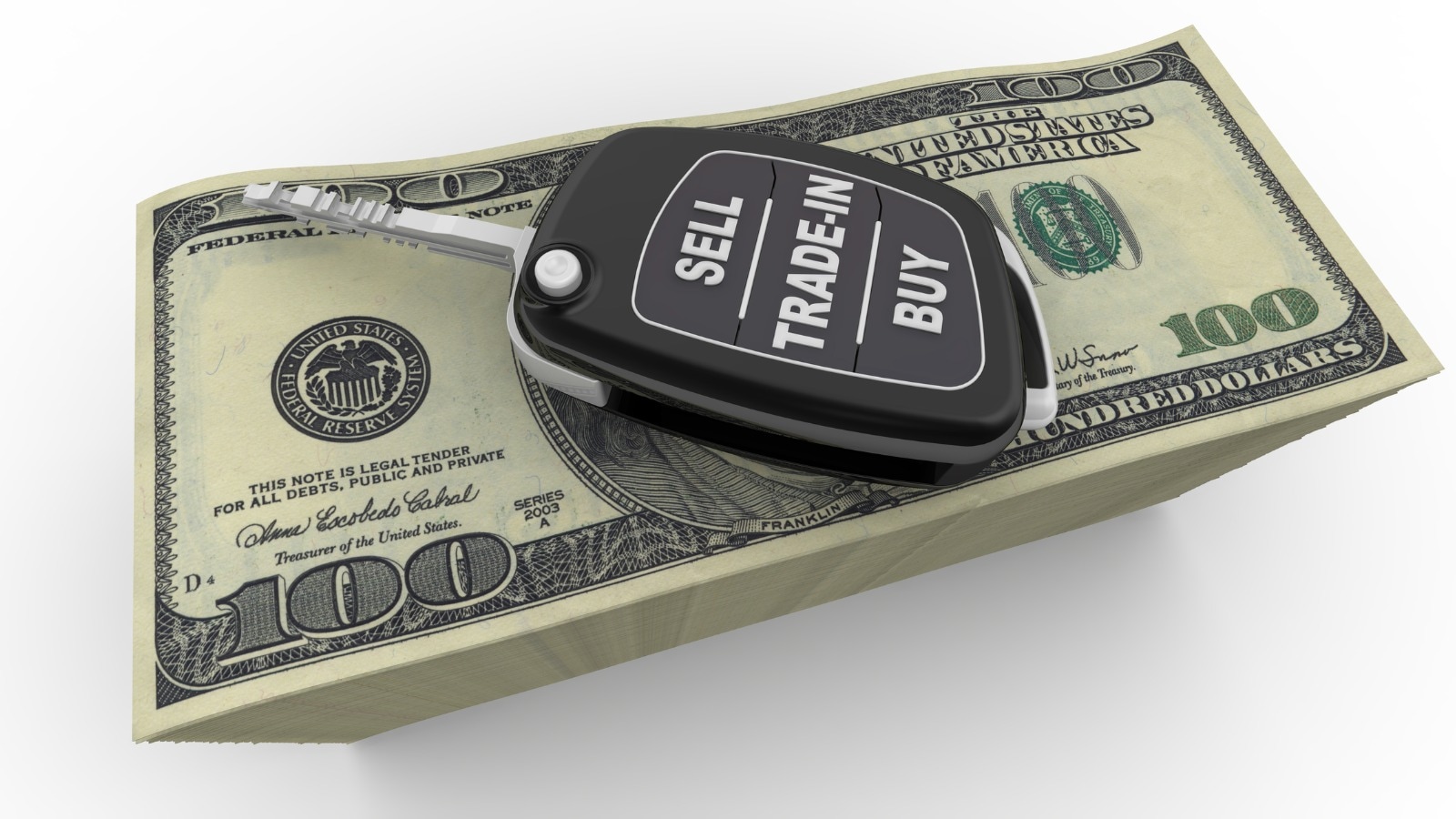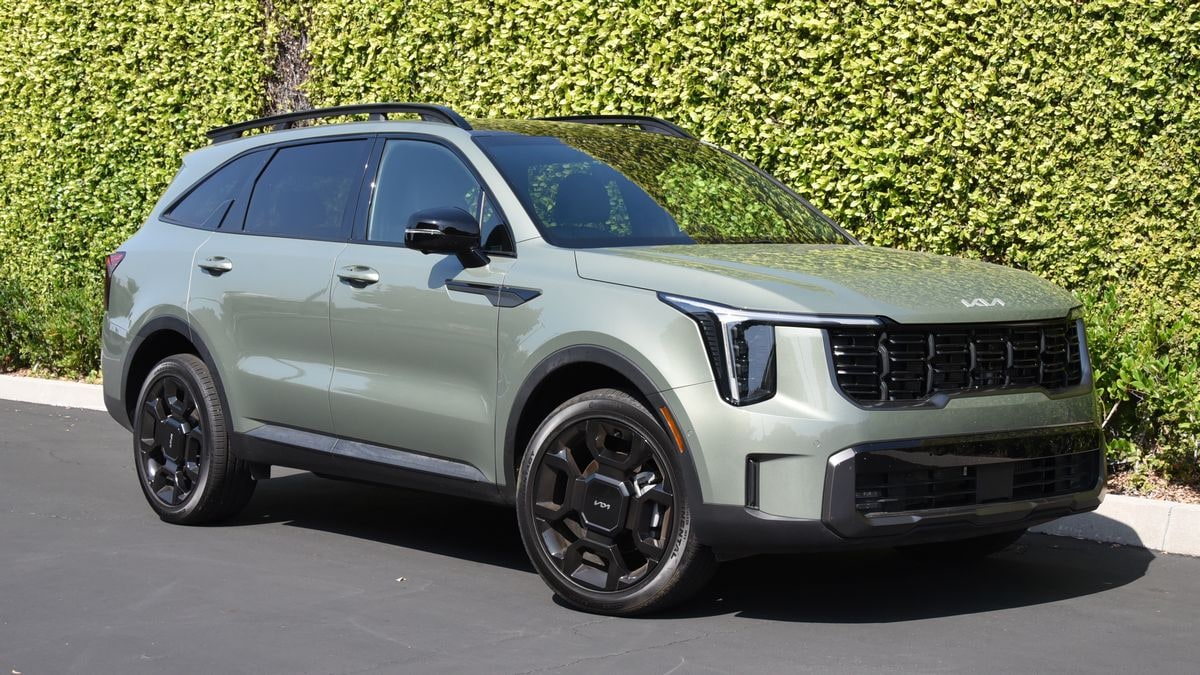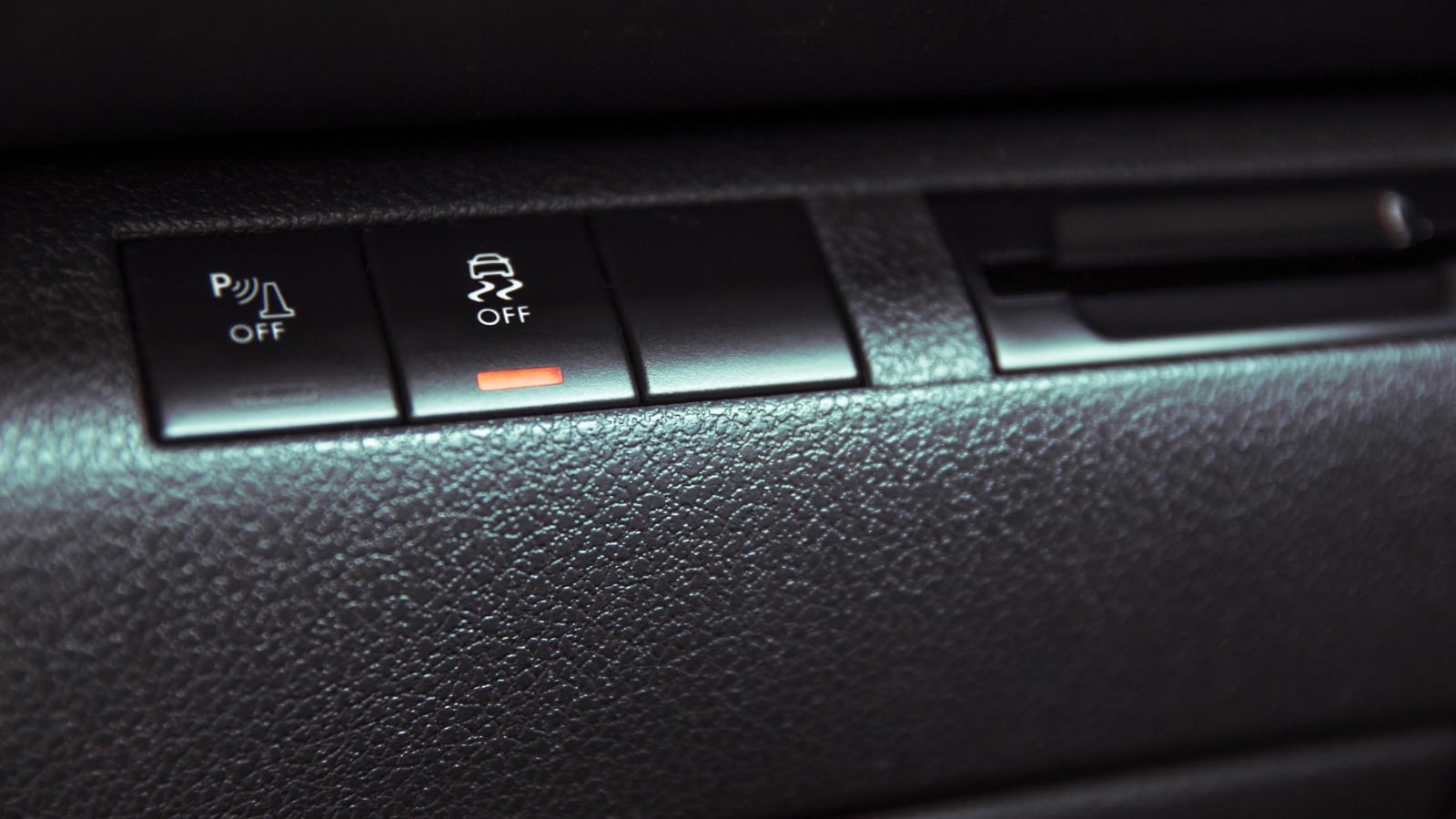Quick Facts About the Car Buying and Selling Marketplace
When analysts from Kelley Blue Book parent company Cox Automotive made their predictions about 2024, they used a word we haven’t seen much in recent years: normal.
“The pandemic created a seller’s market in which new vehicles were transacting above manufacturers’ suggested retail price [MSRP] in 2022,” says Michelle Krebs, Cox Automotive executive analyst. “That market is all but gone now.”
Higher inventories of new cars have many dealers competing with each other by discounting cars. She adds, “Vehicles are now typically selling for under MSRP. The shift from a seller’s market to a buyer’s market is well underway.”
The news isn’t all good. Interest rates remain historically high after a year of Federal Reserve efforts to rein in inflation. New cars are more affordable for many of us, but new car loans aren’t. Used car shoppers face a more complicated market as the supply of used cars remains tighter than usual. But even that situation is improving.
We’ll walk you through what to expect while buying or selling a new or used car or trading one in. Many car shoppers are in both markets simultaneously, with a vehicle to swap. They’re likely to find balanced offers on their trade-in this month. Read on to find out more.
What New Car Shoppers Can Expect
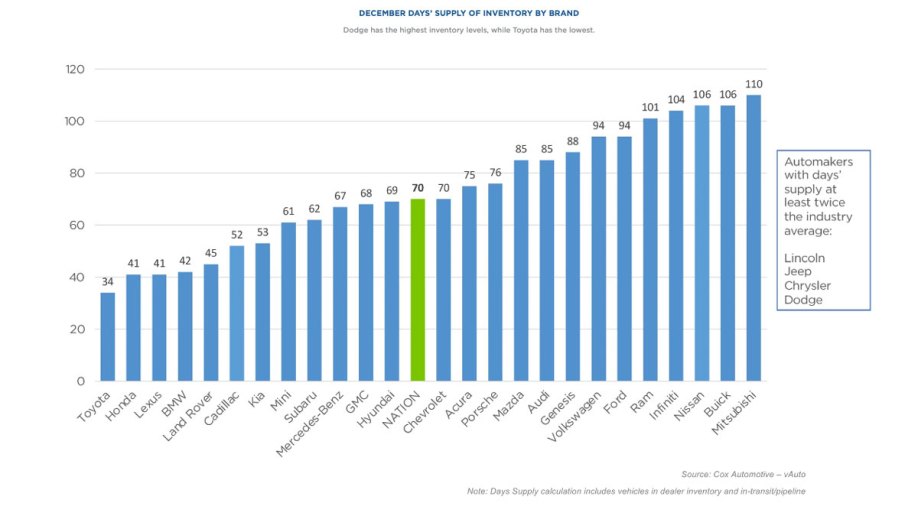
We may all still have sticker shock from the COVID-19 pandemic and the effects of related supply chain problems on new car prices in 2021 and 2022. But the situation is improving faster than most of us realize. The price of the average new car fell by 2.4% in 2023 — the most significant one-year drop on record.
The average new car buyer paid $48,759 in December. That’s 1.3% more than in November but still far less than at the start of last year.
Incentives made up 5.5% of the average sale last month. That’s nearly double where they were at the beginning of 2023. Room remains for discounts to grow — they routinely topped 10% four years ago — but they are steadily rising.
RELATED: When Will New Car Prices Drop?
Discounts appear when dealers are oversupplied. An old rule of thumb in the auto industry tells dealers to keep about 60 days’ worth of new cars in stock. Veteran salespeople say that’s the level at which your local dealership likely has the combination of colors and features you’re seeking in stock.
Many brands are well over that figure now. The average automaker has a 70-day supply; five brands stood at over 100 days at the end of 2023.
It’s still hard to find a good deal at sales lots from several brands—for instance, Toyota and its Lexus luxury marque struggle to stock enough cars. Many Toyota and Lexus vehicles are selling over MSRP. But shoppers gain leverage when a dealer has more cars to sell, and the average brand currently has more than it wants.
Interest Rates Finally Falling
Affordability isn’t just about price. Most of us borrow to pay for a new car and work to repay that loan. High interest rates kept many shoppers out of the market in 2023.
They are, ever so slightly, starting to come down.
The Federal Reserve has held interest rates steady since midsummer. That stability has lenders starting to believe the worst of inflation is behind us. In November, lenders lowered rates. The average new car loan rate almost reached 10% in October and has fallen to 9.7%. The average used car loan rate peaked at 14.4% in mid-November and is now down to 14%.
Those are still high rates, but the trend is moving in shoppers’ favor.
Our favorite measure of car prices doesn’t consider cash. It looks at time. The average earner would now need to work 38.6 weeks to pay off the average new car. That’s historically high — the number hovered between 33 and 36 weeks for most of a decade before 2021. But it’s down from a high of 44 weeks in December 2022.
What Used Car Shoppers Can Expect
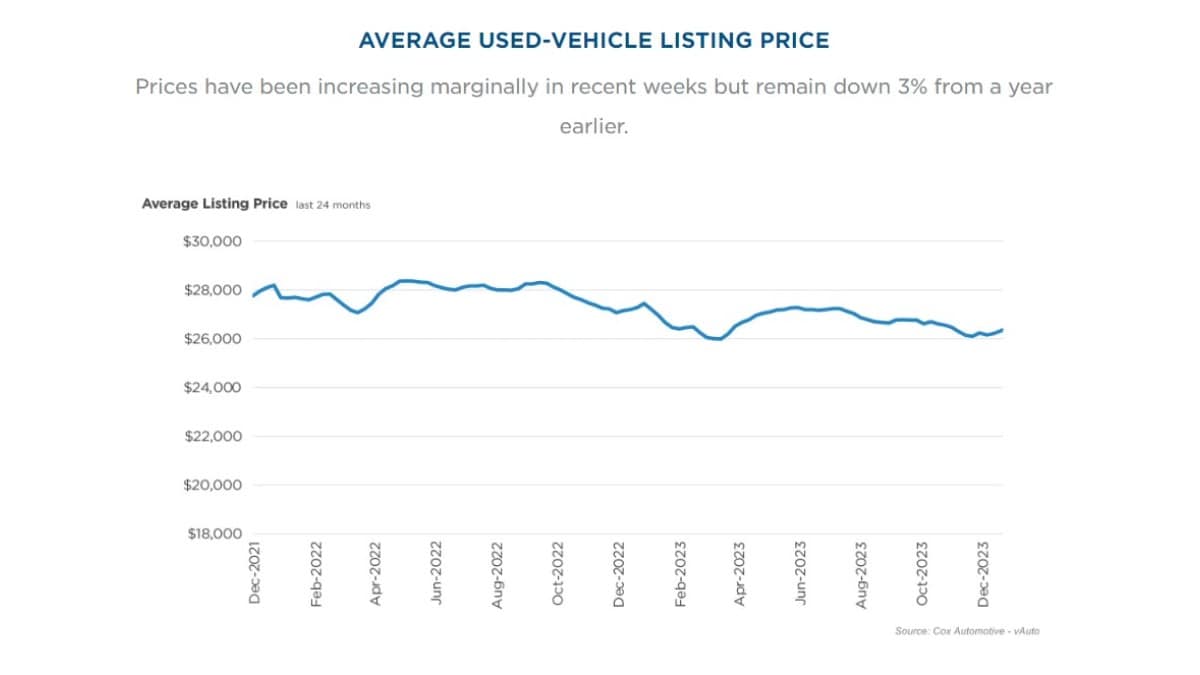
Used car prices, meanwhile, are fluctuating slightly. That’s great news after a long period of dramatic changes.
That’s a short-term increase but part of a long-term decrease. The average list price was 3% lower than one year before.
Car dealers still face a shortage of used cars. But that situation is improving, too.
“After bottoming out at a low historical level in the first quarter of 2023, the supply of used units generally rose throughout most of 2023, ending at roughly the year’s highest levels in both volume and days of supply,” said Jeremy Robb, senior director of Cox Automotive Economic and Industry Insights.
At the end of December, the average dealer held a 56-day supply of used cars — just under the traditional target of 60 days.
The most affordable used cars remain the hardest to find, with dealers struggling to keep cars priced under $15,000 in stock.
Automakers Are Building More Expensive Cars
Though short-term trends are pushing new car prices down, automakers are focusing efforts on building more premium cars. The era of the inexpensive car is disappearing.
A recent analysis finds that sales of cars priced at $25,000 or less have fallen by 78% in just five years. Five years ago, automakers offered 36 new models in that price range. This year, that number is just 10. Meanwhile, those priced at $60,000 or higher have grown by 163% during the same period.
Cox Chief Economist Jonathan Smoke explains the recent Federal Reserve interest rate hikes keep some shoppers from buying cars. “This trend induces automakers to focus on profitable products for consumers who can afford to buy, which keeps less affluent consumers out of the new-vehicle market altogether and limits what is available and possible in the used market for years to come,” Smoke cautions.
Dealers are pushing back, telling automakers they need more affordable cars to sell. But correcting the problem will take time. You’re still likely to find affordable cars in short supply on many sales lots.
Older, Less Expensive Cars Harder To Find
If you hope to find an older vehicle and your budget is less than $15,000, these cars remain in short supply. More would-be new car shoppers started buying up the available used vehicles, drawing down the inventory.
Plus, Americans are holding onto their cars longer than ever. The average vehicle on American roads is now 12.5 years old. Automakers also produced fewer cars for several years after the 2008 recession. That leaves fewer higher-mileage, older used vehicles available to sell.
The most accessible used cars are priced between $15,000 and $30,000. Used cars priced under $15,000 remain challenging to find.
How to Buy a Car Right Now

If you want a new or used vehicle, be prepared for sticker shock. For new cars, prices remain about 18% higher than three years ago when the pandemic seemed never-ending. But take stock that your next car will likely last longer and help you drive safer than ever with all the technological advances and offerings.
RELATED: Buying Older, Used Cars in 2024
Vehicle quality studies repeatedly show that today’s new cars suffer fewer problems than those from just a few years earlier. That means buyers of higher-priced used cars will likely see the vehicle driving on the road even longer. The same goes for those buying new ones.
With most automakers now building such durable cars, they compete by adding more high-tech features. Features like adaptive cruise control and Apple CarPlay are now more common than ever on entry-level vehicles. Read on to see our tips on buying a car below.
How to Leverage Incentives to Buy a New Car
Car incentives made up 5.5% of the average deal in December — up from 2.7% a year before. To take advantage of incentives, read about our monthly best car deals to find dealer or manufacturer incentives, including cash back and lower interest rates for financing your next vehicle.
RELATED: How to Buy a New Car in 10 Steps
Selling a Car Right Now
PRO TIP: If selling a car, consider selling it peer-to-peer using Kelley Blue Book’s Private Seller Exchange marketplace. It’s a low-cost method that helps consumers earn more for their car than selling to a dealership.
Trading In a Car Now
Falling used car prices mean a little less for your trade-in. But the ongoing shortage of used cars will be with us for years. You’ll still likely see respectable offers for your used car this month.
Searching for a decent price for your trade-in is still a good idea by shopping it around. Each dealership tries to keep a balance of vehicles on its lot. Sometimes, the one you want to buy from doesn’t need your trade-in desperately, but a competitor does.
Looking Ahead
According to the Cox Automotive/Moody’s Analytics Vehicle Affordability Index, new vehicle affordability worsened slightly in December but improved through most of 2023. “Due to an increase in average transaction prices, new-vehicle affordability worsened month over month in December,” said Cox Automotive Chief Economist Jonathan Smoke. “However, year over year, it is in much better shape, and new-vehicle loan rates are down from their peak in October.”
Easing inflation could relieve car buyers if the Federal Reserve decides to lower rates in 2024, which could further impact car loan interest rates.
RELATED: 10 Best Used Car Deals
Tips for Buying a Vehicle Right Now

If you shop right now, we recommend a few strategies to help you find the right new or used car that fits your budget.
- Expand your search. Widen your search to a broader geographic area.
- Stay patient. Call dealerships early and often to see what’s coming off the trucks for those harder-to-find vehicles. Leave a refundable deposit if you want first dibs.
- Buy a less expensive model. With higher car loan interest rates, consider buying a cheaper vehicle model instead of a more expensive one in the lineup you’re considering.
- Understand the timing. Be prepared to shop for several weeks, and know it involves calling or visiting several dealerships as you look for the right fit.
- Don’t jump. Shop around your trade-in as aggressively as you seek out the right car. Don’t accept the first offer. You could sell yourself short.
- Weigh your options. Don’t just look for a car; search for the best interest rates from banks or credit unions. Then, weigh all your options, including financing incentives and deals at the dealership, if that’s where you buy your next vehicle. Also, you may find the price differences of some newer model used vehicles are almost the same as new cars. Just keep all your options open during your search.
- Don’t pay dealer markups. If you see a markup, sometimes called a market adjustment, on your final invoice, ask that it be removed or shop at another dealership.
- Question all add-ons. If your sales summary includes entries like “window tint” or “fabric protection” and other add-ons you didn’t request, ask for those line items to be removed from your invoice. Many dealers tack on these extras to make quick profits.
It may make sense to keep your existing car for another year. If you must buy, be prepared to take excellent care of your next car to keep it running for a long time.
Related Articles About Car Buying and Selling:
This article has been updated since it was first published.

